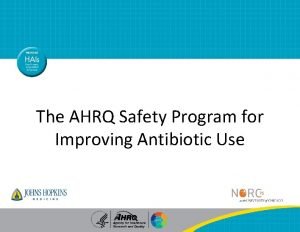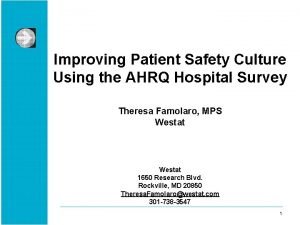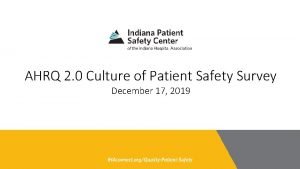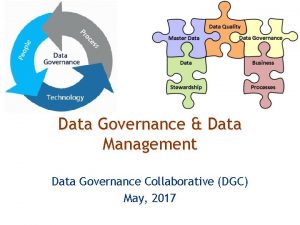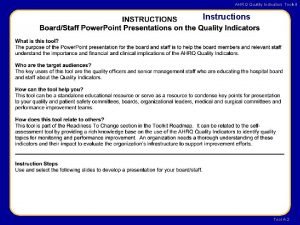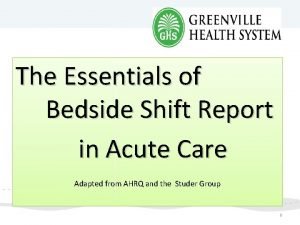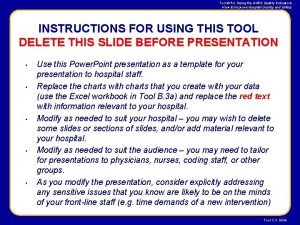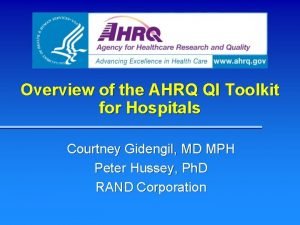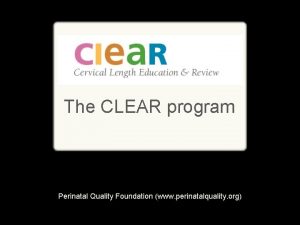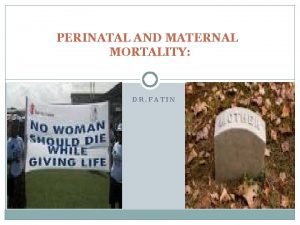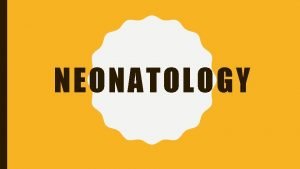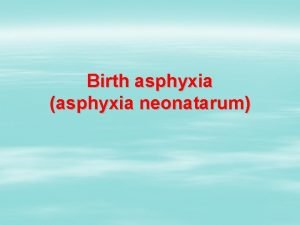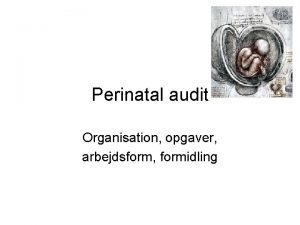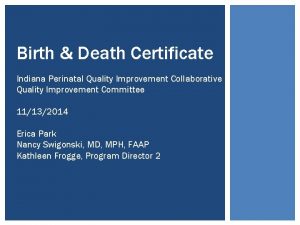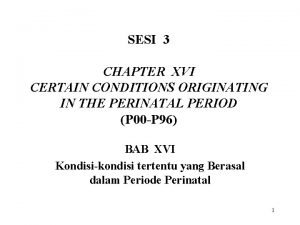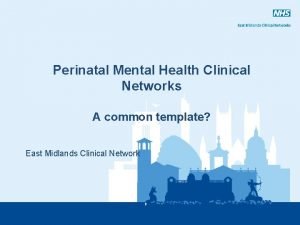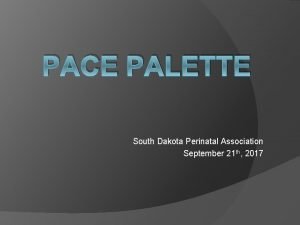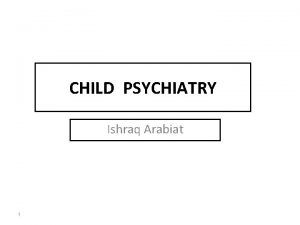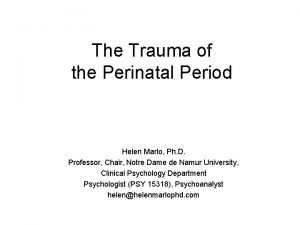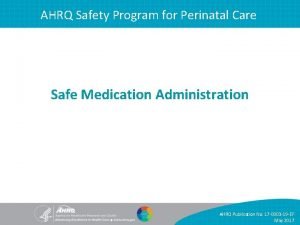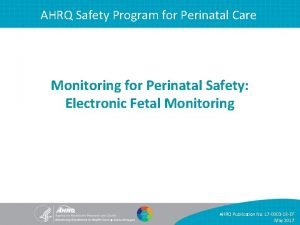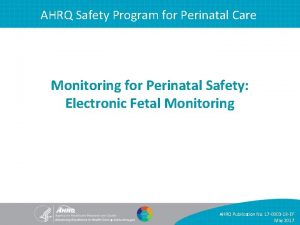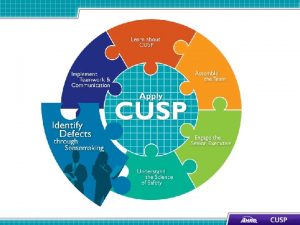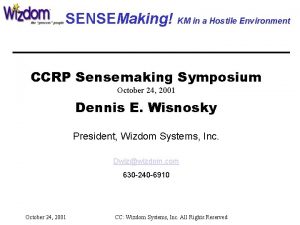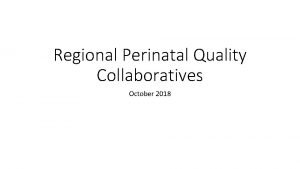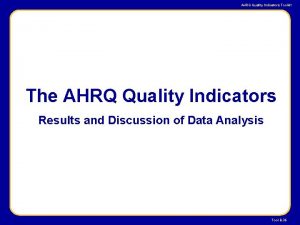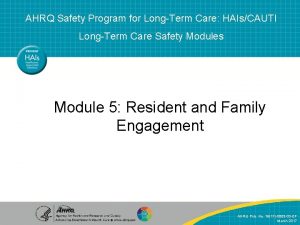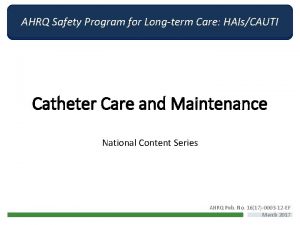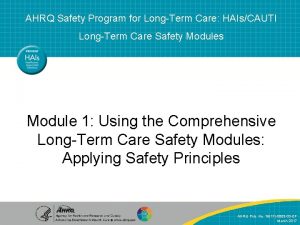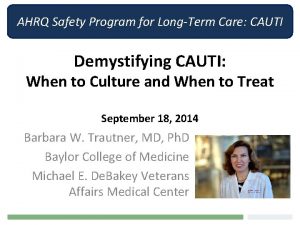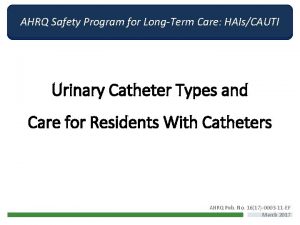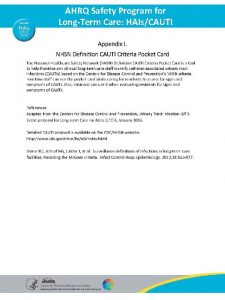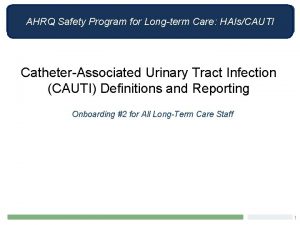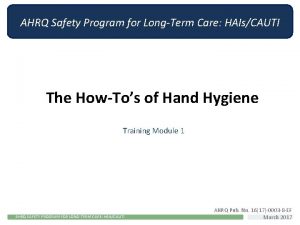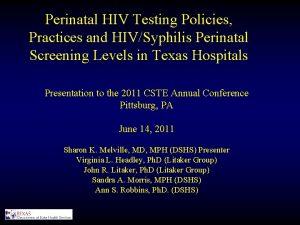AHRQ Safety Program for Perinatal Care Sensemaking and























- Slides: 23

AHRQ Safety Program for Perinatal Care Sensemaking and Learn From Defects for Perinatal Safety AHRQ Publication No. 17 -0003 -5 -EF May 2017

Learning Objectives AHRQ Safety Program for Perinatal Care Sensemaking & 2 Learn from Defects

CUSP and Sensemaking Tools 1 CUSP Tools Sensemaking Tools Staff Safety Assessment Discovery Form Safety Issues Worksheet Root Cause Analysis Learn From Defects Form Failure Mode and Effects Analysis Probabilistic Risk Assessment Causal Tree Worksheet AHRQ Safety Program for Perinatal Care Sensemaking & 3 Learn from Defects

The Relationship Between CUSP and Sensemaking 1, 2, 3 Concept CUSP Sensemaking Defect or failure identification Defects 1. Human/active failure 2. Latent/system conditions Ways to identify defects or failure - Staff Safety Assessment - Status of Safety Issues Worksheet - Discovery Form - Root Cause Analysis - Failure Mode and Effects Analysis - Probabilistic Risk Assessment Tools to examine Learn From Defects Form defects or failures Causal Tree Worksheet Coding defects or Learn From Defects Form failures Eindhoven Model AHRQ Safety Program for Perinatal Care Sensemaking & 4 Learn from Defects

Identify Defects Overview • Define defects • Identify sources of defects • Apply CUSP tools to identify defects AHRQ Safety Program for Perinatal Care Sensemaking & 5 Learn from Defects

Sensemaking Overview 4 • A conversation among members of an organization involved in an event/issue • The purpose is to reduce the ambiguity about the event/issue—literally to make sense of it • Each person brings their experience of that event/issue to the discussion • The conversation is the mechanism that combines that knowledge into a new, more understandable form for the members • Members develop a similar representation in their minds that allows for action that can be implemented and understood by all who participated in the conversation AHRQ Safety Program for Perinatal Care Sensemaking & 6 Learn from Defects

Examples of Defects or Failures That Affect Patient Safety Defect Intervention Medication look-alike Education conducted, medications physically separated, and letter sent to manufacturer Missing equipment on cart Checklist developed for stocking cart Failure to respond rapidly and appropriately to clinical emergencies Staff simulation training, use of checklists to guide response AHRQ Safety Program for Perinatal Care Sensemaking & 7 Learn from Defects

Reason’s Swiss Cheese Model 5 Excerpted from the “Swiss Cheese” Model. Reason J. Human Error. Cambridge: University Press; 1990. AHRQ Safety Program for Perinatal Care Sensemaking & 8 Learn from Defects

Tools for Sensemaking and Learning From Defects AHRQ Safety Program for Perinatal Care Sensemaking & Learn from Defects

Staff Safety Assessment AHRQ Safety Program for Perinatal Care Sensemaking & 10 Learn from Defects

Exercise Please complete the following: • List all defects that have the potential to cause harm • Discuss the three greatest risks • Rank these factors AHRQ Safety Program for Perinatal Care Sensemaking & 11 Learn from Defects

Use the Safety Issues Worksheet for Senior Executive Partnership AHRQ Safety Program for Perinatal Care Sensemaking & 12 Learn from Defects

Root Cause Analysis: Causal Tree Worksheet 6 AHRQ Safety Program for Perinatal Care Sensemaking & 13 Learn from Defects

Learning From Defects Overview • Health care providers are adept at reacting to an event and finding a solution • Providers must also correct the factors that contribute to an event AHRQ Safety Program for Perinatal Care Sensemaking & 14 Learn from Defects

Exercise Think of an unexpected situation that you recently encountered • When did you know it was not what you expected? • What were the clues? • What sense did you make of it? AHRQ Safety Program for Perinatal Care Sensemaking & 15 Learn from Defects

Learning From Defects: Four Questions AHRQ Safety Program for Perinatal Care Sensemaking & 16 Learn from Defects

Causal Coding: Eindhoven Model 6 • 20 separate event cause types in four categories – Technical – Organizational – Human – Other • Aim for three to seven root-cause codes for each event, a mixture of active and latent • All events involve multiple causes AHRQ Safety Program for Perinatal Care Sensemaking & 17 Learn from Defects

Summarize and Share Findings • Create a one-page summary answering the four Learning From Defects questions • Share the summary within your organization – Engage staff in face-to-face conversations to provide opportunities to learn from defects • Share de-identified information with others in your state collaborative (pending institutional approval) AHRQ Safety Program for Perinatal Care Sensemaking & 18 Learn from Defects

Communicating the Learning • Meeting to review data—monthly • Meeting with executive partner—monthly or more often • Executive review of data—monthly • Presentations to hospital colleagues as needed, including leadership, frontline staff, and hospital board AHRQ Safety Program for Perinatal Care Sensemaking & 19 Learn from Defects

Summary: Sensemaking and Learn From Defects • Sensemaking and Learn From Defects share several common themes • Defects or failures are clinical or operational events that you do not want to happen again • CUSP and Sensemaking tools help teams identify defects and identify ways to deter them from occurring in the future AHRQ Safety Program for Perinatal Care Sensemaking & 20 Learn from Defects

References 1. Battles JB, Kaplan HS, Van der Schaaf TW, et al. The attributes of medical event-reporting systems: Experience with a prototype medical event-reporting system for transfusion medicine. Arch Pathol Lab Med. 1998 March; 122: 231 -238. PMID: 9823860. 2. Battles JB, Dixon NM, Borotkanics RJ, et al. Sensemaking of patient safety risks and hazards. Hlth Svcs Res. 2006; 41(Aug 4 Pt 2. ): 1555 -75. PMID: 16898979. 3. Sensemaking. Patient safety analysis training. [Columbia University's Digital Knowledge Ventures is no longer in operation. ] AHRQ Safety Program for Perinatal Care Sensemaking & 21 Learn from Defects

References 4. Sensemaking. Patient safety analysis training. [Columbia University's Digital Knowledge Ventures is no longer in operation. ] 5. Pronovost PJ, Wu AW, and Sexton JB. Acute Decompensation after Removing a Central Line: Practical Approaches to Increasing Safety in the Intensive Care Unit. Ann Intern Med. 2004 June; 140(12): 1025 -33. PMID: 15197020. 6. Sensemaking. Patient safety analysis training. [Columbia University's Digital Knowledge Ventures is no longer in operation. ] AHRQ Safety Program for Perinatal Care Sensemaking & 22 Learn from Defects

Disclaimers Every effort was made to ensure the accuracy and completeness of this resource. However, the U. S. Department of Health and Human Services makes no warranties regarding errors or omissions and assumes no responsibility or liability for loss or damage resulting from the use of information contained within. The U. S. Department of Health and Human Services cannot endorse, or appear to endorse derivate or excerpted materials, and it cannot be held liable for the content or use of adapted resources. Any adaptations of this resource must include a disclaimer to this effect. Reference to any specific commercial products, process, service, manufacturer, company, or trademark does not constitute endorsement or recommendation by the U. S. Government, HHS, or AHRQ of the linked Web resources or the information, products, or services contained therein. The Agency does not exercise any control over the content on these sites. AHRQ Safety Program for Perinatal Care Sensemaking & 23 Learn from Defects
 Ahrq safety program for improving antibiotic use
Ahrq safety program for improving antibiotic use Ahrq safety culture survey
Ahrq safety culture survey Ahrq patient safety survey
Ahrq patient safety survey Weick model
Weick model Master data management mdm vs. sensemaking
Master data management mdm vs. sensemaking Ahrq quality indicators
Ahrq quality indicators Ahrq bedside shift report
Ahrq bedside shift report Ahrq quality indicators toolkit
Ahrq quality indicators toolkit Ahrq qi
Ahrq qi Safety care behavioral safety training
Safety care behavioral safety training Levels of health care primary secondary tertiary
Levels of health care primary secondary tertiary Clear perinatal quality
Clear perinatal quality Perinatal matrices
Perinatal matrices Perinatal mortality rate
Perinatal mortality rate Perinatal asphyxia
Perinatal asphyxia Perinatal asphyxia
Perinatal asphyxia Perinatal audit
Perinatal audit Perinatal anoksiya
Perinatal anoksiya Indiana perinatal quality improvement collaborative
Indiana perinatal quality improvement collaborative Certain conditions originating in the perinatal period
Certain conditions originating in the perinatal period Ccqi perinatal standards
Ccqi perinatal standards South dakota perinatal association
South dakota perinatal association Perinatal risk factors
Perinatal risk factors Perinatal adalah
Perinatal adalah
